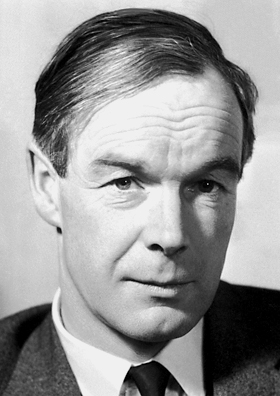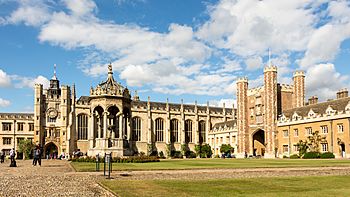Alan Hodgkin facts for kids
Quick facts for kids
Alan Lloyd Hodgkin
|
|
|---|---|
 |
|
| Born | 5 February 1914 Banbury, Oxfordshire, England
|
| Died | 20 December 1998 (aged 84) Cambridge, England
|
| Nationality | English |
| Citizenship | British |
| Education | The Downs School Gresham's School |
| Alma mater | University of Cambridge |
| Known for | Hodgkin cycle Hodgkin–Huxley model Hodgkin–Huxley sodium channels Goldman–Hodgkin–Katz flux equation Goldman–Hodgkin–Katz voltage equation |
| Spouse(s) | Marion Rous |
| Children | Sarah, Deborah, Jonathan Hodgkin, and Rachel |
| Awards |
|
| Scientific career | |
| Fields | Physiology Biophysics |
Sir Alan Lloyd Hodgkin (born February 5, 1914 – died December 20, 1998) was an English scientist. He studied how our bodies work (a physiologist) and how physics applies to living things (a biophysicist). He won the 1963 Nobel Prize in Physiology or Medicine with Andrew Huxley and John Eccles for their amazing discoveries about how nerves send messages.
Contents
Early Life and Education
Alan Hodgkin was born in Banbury, England, on February 5, 1914. He was the oldest of three sons. His parents, George and Mary Hodgkin, were part of the Quaker community.
His father, George, had studied science at Cambridge. He died in 1918 while helping Armenian refugees in Baghdad.
From a young age, Alan loved exploring nature. He was especially interested in birds. When he was 15, he helped with surveys of heronries, which are places where herons nest.
Alan went to The Downs School and then Gresham's School. He earned a scholarship to Trinity College, Cambridge to study Botany, Zoology, and Chemistry.
Before starting college, he spent time at a biological station and learned German in Frankfurt. In 1932, he began his studies at Trinity College, Cambridge. He focused on physiology, which is the study of how living things work.
Pre-War Research on Nerves

In 1934, Hodgkin started studying how electrical signals travel in frog nerves. He found that a nerve impulse could affect the electrical activity in the nerve beyond a block. This suggested that the impulse spreads an electrical signal.
In 1936, he was invited to work at the Rockefeller Institute in New York City. There, he met other scientists and learned about the giant axon of squids. This large nerve fiber became very important for his future research.
He also showed that nerve signals travel faster in seawater than in oil. This proved his idea that electrical signals spread through the fluid around the nerve.
After returning to Cambridge, he began working with Andrew Huxley. In 1939, they successfully put a tiny tube into a squid's giant axon. This allowed them to record electrical signals from inside the nerve fiber for the first time. They published their findings just before World War II began.
Wartime Contributions
Even though he was raised a Quaker, Hodgkin wanted to help with the war effort. He worked on important projects during World War II.
First, he worked on aviation medicine, studying how pilots could get enough oxygen at high altitudes. Then, he joined the Telecommunications Research Establishment (TRE).
At TRE, he helped develop radar technology. He worked on systems that helped planes aim their guns. He even flew on a test flight of a plane with the first airborne radar system.
Hodgkin later wrote a book called Chance and Design about his experiences during the war. He wanted people to know about the important scientific work done during that time.
Action Potential Theory and Nobel Prize
After the war, Hodgkin went back to his research at Cambridge. He continued his work with Bernard Katz and Andrew Huxley. They spent summers at the Plymouth Marine Laboratory, studying squid giant axons.
They found that during a nerve impulse, the nerve cell membrane becomes more open to sodium ions. This allows sodium to rush into the cell.
Their research led to the famous Hodgkin–Huxley model. This model explains how nerve cells create and send electrical signals, called action potentials. They used a special technique called voltage clamp to measure how ions move across the nerve membrane.
Their model showed that changes in how easily different ions (like sodium and potassium) can cross the membrane create the nerve impulse. This groundbreaking work earned Hodgkin and Huxley the Nobel Prize in Physiology or Medicine.
They also described the Hodgkin cycle. This is a process where a small electrical change in the nerve leads to more sodium entering, which causes an even bigger electrical change.
Their work also suggested that there must be tiny "ion channels" on cell membranes. These channels act like gates, letting specific ions in or out. Scientists later confirmed the existence of these channels, leading to more Nobel Prizes for other researchers.
Hodgkin also studied how nerve cells recover after sending a signal. He and Richard Keynes showed that cells actively pump sodium out and potassium in, even against their natural flow. Later, another scientist discovered the Na+/K+-ATPase enzyme, which does this work.
In 1963, Hodgkin, Huxley, and Eccles were awarded the Nobel Prize. They received it for their discoveries about how nerve cells create and stop electrical signals.
Later Career and Awards
From 1951 to 1969, Hodgkin was a professor at Cambridge. He later became the John Humphrey Plummer Professor of Biophysics. He also served as the president of The Royal Society, a famous scientific organization, from 1970 to 1975.
During his time as president, he was knighted in 1972, becoming "Sir Alan Hodgkin." He also received the Order of Merit in 1973, a special honor given by the British monarch.
From 1978 to 1984, he was the Master of Trinity College, Cambridge, where he had studied as a young man. He received many other awards and honors throughout his life for his contributions to science.
Awards and Honours
- 1988 – W.H. Helmerich III Award
- 1983 – Lord Crook Medal
- 1982 – F.O. Schmitt Medal and Award
- 1977 – Hon. DSc, University of Oxford
- 1975 – Hon. Fellow, Indian Academy of Sciences
- 1974 – Foreign Associate, National Academy of Sciences of the USA
- 1973 – Order of Merit (O.M.)
- 1973 – Foreign Member, Royal Swedish Academy of Sciences
- 1972 – Knight Commander of the Order of the British Empire (K.B.E.)
- 1972 – Hon. Fellow, Indian National Science Academy
- 1970 – President of the Royal Society (PRS)
- 1968 – Member, Pontifical Academy of Sciences
- 1968 – Foreign Member, American Philosophical Society
- 1966 – President of the Marine Biological Association of the United Kingdom
- 1965 – Copley Medal of the Royal Society
- 1964 – Foreign Member, Royal Danish Academy of Sciences and Letters
- 1964 – Member, German National Academy of Sciences Leopoldina
- 1963 – Nobel Prize for Physiology or Medicine
- 1962 – Foreign Hon. Member, American Academy of Arts and Sciences
- 1958 – Royal Medal of The Royal Society
- 1958 – Hon. MD, University of Louvain
- 1956 – Hon. MD, University of Berne
- 1955 – Baly Medal of the Royal College of Physicians
- 1948 – Fellow of The Royal Society (FRS)
Publications
- The Conduction of the Nervous Impulse (1964)
- Chance and Design: Reminiscences of Science in Peace and War (1992)
Personal Life
In 1937, while working in the US, Hodgkin met Marion Rous, known as Marni. She was the daughter of Francis Peyton Rous, who also won a Nobel Prize in Medicine later. Alan and Marni married in 1944.
They had four children: Sarah, Deborah, Jonathan Hodgkin, and Rachel. Marni became a successful children's book editor and writer. Their son, Jonathan, became a molecular biologist, and Deborah became a psychologist.
Alan Hodgkin was related to Thomas Hodgkin, a doctor who first described Hodgkin's lymphoma, a type of cancer.
Alan Hodgkin passed away in Cambridge in 1998.
See also
 In Spanish: Alan Lloyd Hodgkin para niños
In Spanish: Alan Lloyd Hodgkin para niños
Images for kids




